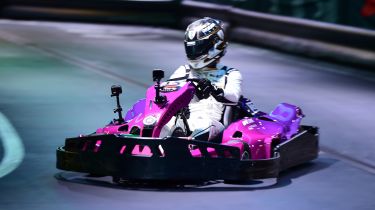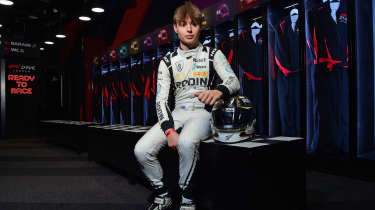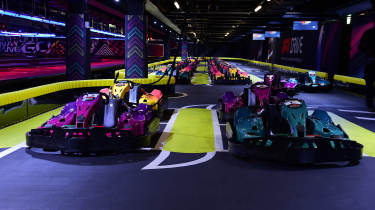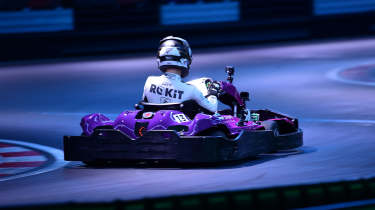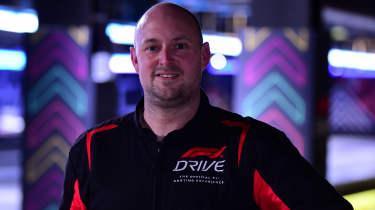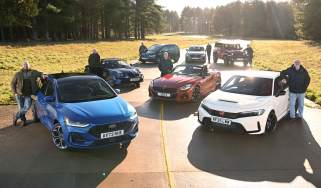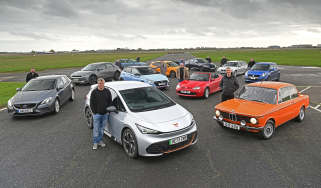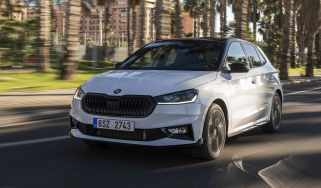F1 Drive: ultimate go-karting experience tested by pro racer
F1’s exciting new driving experience is open for business in London. We asked F4 star Louis Sharp to give us his verdict
There’s no end of evocative names when it comes to Formula One racing circuits: Silverstone, Spa, Monza, Monaco and now Las Vegas, too. But Tottenham?
Hidden away underneath the Tottenham Hotspur Stadium in London is a new attraction that’s aimed at following Netflix’s Drive To Survive in taking F1 to a new audience. F1 Drive is a karting experience that’s set to give fans a taste of the real thing – and Auto Express was one of the first to take a look.
However, when it came to driving around the new 500-metre, 17-turn circuit, we had someone special up our sleeve: current British Formula Four champion (and, we reckon, future F1 star) Louis Sharp. We last met Louis 18 months ago when he was just into Formula Four – and couldn’t complete the whole season because he was too young. He went on to win the championship in his first full year of competition.
Now 16 and still not legally allowed to drive on the road, Louis has moved up to GB3, won first time out at Oulton Park and, at the time of writing, sits second in the championship table. You get the drift – he’s a bit special. And that was instantly recognised by the F1 Drive team the moment our ringer took to the track.
More of that later, but there’s much more to the F1 Drive experience than just a kart and a track. As an engineering feat, it’s a thing of wonder. It lives directly underneath the famous South Stand in the Tottenham Hotspur stadium, which is the biggest single club stand in the UK, holding 17,500 fans on a match day (or rock concert, boxing match, NFL or rugby match, or any of the other events held at the 62,850-seater venue).
F1 Drive is the latest attraction to be added to the Stadium roster – you can do a stadium tour, walk out 47 metres over the pitch from the roof or even abseil down the side. Obviously, we couldn’t resist a quick look in the Tottenham Hotspur home changing room – and sitting in captain Son Heung-Min’s seat – but for us it was all about the F1 experience. And although this is a karting track, it feels unlike any other karting circuit we’ve ever been to – and very F1.
This is the first F1 Drive to launch, so – as you’d expect – F1 has been meticulous about the branding and the environment. This is as far away as you can get from the disused bus garage or unloved warehouse most other karting circuits live in. You enter through the Club shop, walk down an F1-branded tunnel and eventually reach the sign-up desks. It’s clean, slick, professional… and electric.
Yes, the karts are battery-powered, with a row of them lined up, connected to chargers, getting ready to race. Most are single-seaters, although there are some two-seat models, so that anyone who can’t drive – for age or accessibility reasons – can still get a taste of F1.
And there’s plenty of F1 tech in the karts, which (like so many of the F1 cars) are designed and built in the UK. Slide yourself behind the steering wheel – there are different-sized karts for those of us who aren’t built like pro drivers – and the premium tech is immediately apparent straight in front of you. The steering wheel features an 18cm LCD display slap bang in the middle, with buttons for Drive and Reverse, plus two more intriguing selectors: one marked ERS Boost, and the other with the of the most famous – or possibly infamous – letters in F1: DRS.
The Drag Reduction System doesn’t open a flap in a rear spoiler to boost your speed, it just gives your car a performance boost when you’re close to the car in front. As for ERS Boost, it’s another power enhancement – as it is in an F1 car – to help overtake or fend off the wannabe Louis Sharps approaching rapidly from behind.
The screen lets you know how much boost you’ve got, while also highlighting your lap times, intervals and any flags being waved – that’s assuming you can take your eyes of the track, with its exciting neon lighting overhead.
Although the karts are electric, they’re clearly not short of pace – or sound. Speakers pipe through engine effects taken from last year’s Red Bull, Mercedes and Ferrari cars (although spectators will just hear a combination of the whizz of the karts passing and screech of the tyres through the corners), while the familiar voices of F1 commentator David Croft and F1 analyst Naomi Schiff act as race engineers to give you tips as you go around.
Crofty’s also on hand during the obligatory driver briefing, which takes place once you’ve been kitted out with your wristband, balaclava, F1-branded helmet and race suit – it’s all as slick as you’d expect with F1’s usual attention to detail. You can even take part in a pit-stop challenge to change the tyres on an F1 car.
Louis turned up in his championship-winning Rodin Motorsport race suit and helmet, and was clearly itching to be let loose on the circuit. So how did he feel about getting behind the wheel of a kart again?
“I’m really looking forward to it,” he admitted. “To be honest, it’s been a while since I’ve been in a go kart, and they’re electric so it’ll be something a bit different to learn. But it looks fantastic. I’m blown away by the size of the [three] tracks and I can’t wait.”
As the five red lights went out – again mimicking those at F1 circuits around the world – Louis was off in a squeal of tyres. And he quickly impressed the F1 Drive team, with one of them instantly spotting the strength in Louis’s neck, meaning his head wasn’t wobbling around with the G forces that were affecting the mere mortals also on track that day.
As with other attendees, Louis made full use of his two 15-minute stints, although he was only up against the clock rather than other drivers. He came in, swapped into another kart, which the team had adorned with Louis’s championship-winning number 11, and went out again.
The key to getting a fast time, we were told, is not only pure skill and a natural ability to drive quickly, but also familiarity with the karts and the track, making the best use of the ERS Boost and DRS.
From the sidelines, alongside Louis’s father Jason, who’s left their home in New Zealand to accompany his son on his rise towards F1, Louis looks super-quick and composed, rattling off lap after lap with less of the tyre squeal that we’d seen from others – and less of the crash barrier bashing that one driver managed while we were standing alongside.
Louis was playing with different lines and trying to make the most of the boosts available, and clearly could have stayed out there all day. And as all racing drivers do, he stepped out of the kart, took off his helmet, ran his fingers through his hair and hadn’t even broken sweat, where other drivers looked as though they’d had the toughest of workouts.
So what did our future F1 star make of F1 Drive? “It was amazing,” said Louis. “Honestly, it definitely exceeded my expectations. It’s been a while since I’ve been in a go kart, so I was looking forward to coming down, but having had a go now, it’s been phenomenal.
“With the ERS and the DRS simulating what it’s like for a real F1 driver, I thought that was really cool.” He added: “I don’t think any other indoor go kart place has something like that. The track layout was super-fun as well; a lot of twisty corners and some good straights. It was a blast.
“I’m definitely going to be coming back in the future, especially with a couple of my mates – I think that would be a lot of fun. I’d 100 per cent recommend it.”
When it came to the crucial lap time, Louis impressed everyone at F1 Drive first time out – as he has done in anything with four wheels he’s ever driven. His best lap, measured F1-style right down to the last thousandth of a second, was 43.545 seconds. To put that time into context, two F1 drivers – Kevin Magnussen and Nico Hulkenberg – had been down to F1 Drive a few weeks beforehand and Louis beat their times by over a second. Impressive stuff.
Formula 1’s director of commercial partnerships, Jonny Haworth, said that the aim of F1 Drive was “To create a karting experience that captures the feeling and atmosphere of Formula 1, and to offer an accessible entry point to our sport for as many people as possible.”
Judging by Louis’s reaction, it’s job done. We’d agree – and with prices starting at £35 for two 15-minute sessions for kids, rising to £85 for an Elite session with the full Grand Prix experience, including the podium at the end, we’d say it’s decent value for money, too.
And although Louis couldn’t persuade us to do battle with him on track, we did agree to line-up for a 30-minute race on F1 Drive’s impressive full-motion simulators that are also available.
Amazingly, we seemed to keep pace with Louis around the Silverstone Grand Prix track for, well, about a few hundred yards. After we’d both pitted for tyres, he did the decent thing and waited for us so we could cross the finish line together – before cruelly punting us off the track on the final corner and going on to take the chequered flag himself. It’s all fabulous fun and we can now say we’ve raced a future Formula One star around Silverstone – and lost. Badly!
Case study: birthday boy takes to the track
Ross Boulton’s wife bought him an F1 Drive Experience for his birthday and this was his first visit. So how did the birthday boy get on?
“It’s brilliant,” said Ross. “It’s much quicker than I thought it was going to be. Clearly you hear that they’re electric and obviously electric cars get up to speed quickly, but the karts are really nippy and really grippy.”
Ross has been an F1 fan for 37 years since the age of four, so did he feel that he’d got a real F1 experience? “Yeah, it’s really good,” he said. “They’ve done it really well – there’s lots of memorabilia about, so it’s really good for any F1 fan to come down and have a go.
“The kart felt heavy to start with, but once you get going, it just gets lighter and lighter. And then you’re just finding grip here, there and everywhere, and exploring all the corners. So yeah, it’s a really good experience.”
Click here for our list of the best performance cars...
Find a car with the experts

